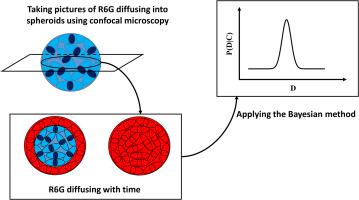Journal of Controlled Release ( IF 10.8 ) Pub Date : 2021-10-09 , DOI: 10.1016/j.jconrel.2021.10.002 Miad Boodaghi 1 , Sarah Libring 2 , Luis Solorio 2 , Arezoo M Ardekani 1

|
Multicellular spheroids have emerged as a robust platform to model tumor growth and are widely used for studying drug sensitivity. Diffusion is the main mechanism for transporting nutrients and chemotherapeutic drugs into spheroids, since they are typically avascular. In this study, the Bayesian inference was used to solve the inverse problem of determining the light attenuation coefficient and diffusion coefficient of Rhodamine 6G (R6G) in breast cancer spheroids, as a mock drug for the tyrosine kinase inhibitor, Neratinib. Four types of breast cancer spheroids were formed and the diffusion coefficient was estimated assuming a linear relationship between the intensity and concentration. The mathematical model used for prediction is the solution to the diffusion problem in spherical coordinates, accounting for the light attenuation. The Gaussian likelihood was used to account for the error between the measurements and model predictions. The Markov Chain Monte Carlo algorithm (MCMC) was used to sample from the posterior. The posterior predictions for the diffusion and light attenuation coefficients were provided. The results indicate that the diffusion coefficient values do not significantly vary across a HER2+ breast cancer cell line as a function of transglutaminase 2 levels, even in the presence of fibroblast cells. However, we demonstrate that different diffusion coefficient values can be ascertained from tumorigenic compared to nontumorigenic spheroids and from nonmetastatic compared to post-metastatic breast cancer cells using this approach. We also report agreement between spheroid radius, attenuation coefficient, and subsequent diffusion coefficient to give evidence of cell packing in self-assembled spheroids. The methodology presented here will allow researchers to determine diffusion in spheroids to decouple transport and drug penetration changes from biological resistivity.
中文翻译:

一种估计罗丹明 6G 在乳腺癌球体中扩散系数的贝叶斯方法
多细胞球体已成为模拟肿瘤生长的强大平台,并广泛用于研究药物敏感性。扩散是将营养物质和化疗药物输送到球体中的主要机制,因为它们通常是无血管的。在这项研究中,贝叶斯推理被用来解决确定罗丹明 6G (R6G) 在乳腺癌球体中的光衰减系数和扩散系数的逆问题,作为酪氨酸激酶抑制剂 Neratinib 的模拟药物。形成了四种类型的乳腺癌球体,并假设强度和浓度之间存在线性关系来估计扩散系数。用于预测的数学模型是球坐标系中扩散问题的解,考虑了光衰减。高斯似然用于解释测量和模型预测之间的误差。马尔可夫链蒙特卡罗算法 (MCMC) 用于从后验采样。提供了扩散和光衰减系数的后验预测。结果表明,作为转谷氨酰胺酶 2 水平的函数,扩散系数值在 HER2+ 乳腺癌细胞系中没有显着变化,即使存在成纤维细胞。然而,我们证明了不同的扩散系数值可以从致瘤性与非致瘤性球体相比以及从非转移性与转移后乳腺癌细胞相比使用这种方法确定。我们还报告了球体半径、衰减系数、和随后的扩散系数,以提供自组装球体中细胞堆积的证据。这里介绍的方法将使研究人员能够确定球体中的扩散,以将运输和药物渗透变化与生物电阻率分开。



























 京公网安备 11010802027423号
京公网安备 11010802027423号